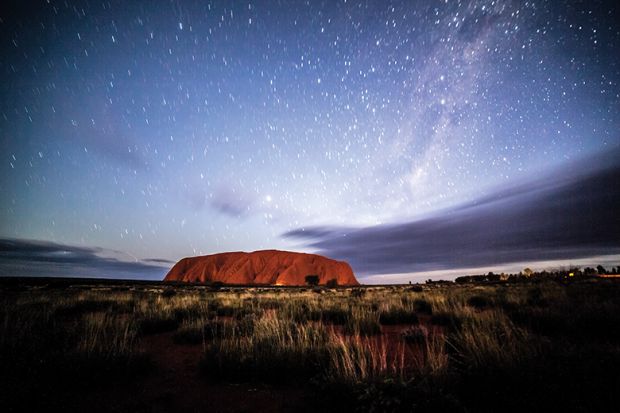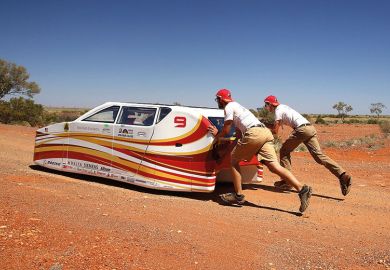Australia’s long-awaited re-entry into space promises powerful payloads for universities, according to the woman appointed to head the country’s first space agency.
Megan Clark said that a sweeping “reinvention” of the global space industry would present opportunities for researchers working with the new organisation to “leapfrog” longer-established competitors in areas such as navigation systems, next-generation lasers, artificial intelligence, data management and quantum computing.
Dr Clark argued that Australian universities’ infrastructure and research strengths made them well placed to contribute to the agency, the creation of which was confirmed in the Canberra government's budget earlier this month. She said that they would reap benefits in teaching, research and commercialisation while cultivating cooperation between public research and business – an area in which Australia has been notoriously weak.
“We have nascent areas where it will be strategically advantageous to make sure we invest in research and development,” Dr Clark said. “How do we get industry to better engage with universities to pull some of this through? I’m seeing some really nice momentum there.”
A geologist and former mining executive, Dr Clark headed Australia’s Commonwealth Scientific and Industrial Research Organisation for five years and is now a director of mining and biotech giants Rio Tinto and CSL. She is considered an ideal pick to guide the space agency’s formation, not only because of her government and industry links but also because she led the review that recommended its establishment.
Earlier this month, the government formally responded to her panel’s report, endorsing all nine recommendations and appointing her to lead the agency for its first year. It also allocated A$41 million (£23 million) in this month’s budget, including A$26 million for four years of operational funding and A$15 million for an investment fund.
While that is less than commentators had hoped, the government has also earmarked A$289 million for satellite-based global positioning and imagery systems. Andrew Dempster, director of the Australian Centre for Space Engineering Research at the University of New South Wales, said that this would fund infrastructure for big satellite missions.
Professor Dempster said that the government was investing just as a “new space paradigm” – known as “space 2.0” – heralded the entry of dozens of start-up companies in a sector traditionally dominated by multinationals and “big old space agencies”.
The new paradigm includes large commercial ventures such as Elon Musk’s SpaceX, Virgin Galactic and space station manufacturer Bigelow. But it also includes small companies harnessing miniaturised technologies and commercially manufactured components – a practice pioneered by the University of Surrey – to build small rockets and satellites.
“You’ve got small companies which need technological input and start working closely with universities,” Professor Dempster said. “We get good research projects; they get their businesses accelerated; the government creates jobs. It’s good news all round.”
Last year, three lunch box-sized “cubesats” – built by researchers at five Australian universities, many of them students – became the first locally built satellites launched into orbit since 2002. Professor Dempster said that there were exciting research opportunities in the development of novel materials and precision instruments, particularly for new types of satellites.
He said that satellites underpinned the entire economy, with sectors such as communications, agriculture and mining relying on them for timing, positioning or remote sensing data. “Australia does not make its own satellites; it just gets data from other people,” he said. “We need to be much more in control of how we go about solving our own problems.”
Further afield, space mining also promises potential riches. Dr Clark said that Australia’s expertise in “remote asset management”, honed in the mines of Western Australia, offered a “natural partnership” with space science.
She said that commercial space enterprises could also piggyback on university-run astronomy facilities such as the radio telescopes at Tidbinbilla, near Canberra, and the Square Kilometre Array sprouting in Western Australia’s Murchison region. No-fly zones around some telescopes, and the fibre links that they used to transmit data, made them ideal sites for space companies’ ground stations.
“There’s an overlap there,” Dr Clark said. “The question is, how do we open up that infrastructure for commercial use?”
Such problems echo the glory days of the 1960s, when Australia became the third nation in the world to launch its own satellite. Dr Clark said that far from being a “distraction” that drew resources from other research priorities, the space agency would catapult universities into a sector projected to grow at 8 per cent a year – a rate matched only by health and biomedicine.
“Universities need to connect with fast-growing industries,” she said.
Register to continue
Why register?
- Registration is free and only takes a moment
- Once registered, you can read 3 articles a month
- Sign up for our newsletter
Subscribe
Or subscribe for unlimited access to:
- Unlimited access to news, views, insights & reviews
- Digital editions
- Digital access to THE’s university and college rankings analysis
Already registered or a current subscriber?










